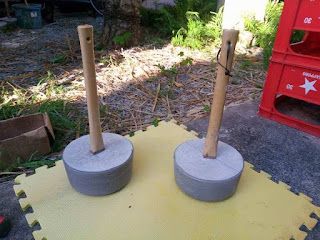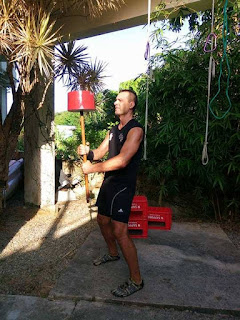I believe everyone should have a bucket list.
It gives you goals to aim for, helps you discover more about yourself and it's super cool when you actually achieve them.
Some of these are things are exclusive to Okinawa, some are things that can be done anywhere. Some are instantly achievable, some take a lot of dedication and life changes.
My bucket list was one of the reasons i took the jump and moved to Okinawa.
but now i'm digressing...
With how fast 2017 is flying by I decided i needed to stop wasting time and start doing these 'one day' things, you know, those things that you would love to do/ will do 'one day'.
On my list was to make my very own training equipment that you will find in almost every single traditional Okinawan karate dojo.
Chi-ishi and a Makiwara.
We started with the Chi-ishi, used to train core strength and control to improve karate.
Sounds good to me, but how do we do it, and what do we need?
It seems it's pretty simple and only requires a few ingredients-
1- Ready Mixed Cement
2- Hammer Handles (without the hammer)
3- Nails
4- Buckets/ whatever shape container you want your chi-ishi to be (can be reused if careful)
5- Paint (optional)
Step 1-
Get a James to help.
The strong arms and knowledge of power tools is valuable in making sure you end up with some nice equipment at the end (and a good place to play with them).
Step 2-
Mix up the cement. Easy enough, I could even do this part all by myself, without any help.
Think of it like making a boxed cake mix. Pour the powder in the bowl and add the water. Voila- you have your cement.
Take your hammer handles and put the nails through the end- drill a hold first so as not to split the wood. Put them in the shape of a cross so that they are even. The nails are there so that the cement has something to stick to and it won't just fall apart later.
Step 4-
Choose your bucket. Pour in the cement.
Step 5-
Place the hammer handles in the centre of the bucket- if they're not centered, your chi-ishi will be off balance.
If it was me by myself, i would have probably sat and waited for them to dry, but i had a James who's smart and set up a little drying station to hold the handles where they should be while the cement set.
At this point you should make sure the handles are straight and that you tap the buckets a bit to make sure there are no air bubbles.
Step 6-
wait a couple of days, or just one in the Okinawan summer.
Step 7-
Remove them from the bucket (this might involve kicking it a few times).
Step 8 (optional)-
If you like, you can just go ahead and use them as they are, but because there is quite a high possibility i will drop them (i'm a first timer) and also because i'm in love with blue. We decided to paint them, with the idea that the paint will stop them shattering if they are dropped. We also chose hammer handles with holes in the end so we can add a wrist strap.
Here we have our finished chi-ishi.
It was much easier than i was expecting, then again the traditional training tools apparently are usually things you have hanging around or are easy to make.
We didn't aim for a specific weight, nor did we make sure they matched exactly. Some might want to be more precise but for a first attempt, I'm happy.









No comments:
Post a Comment